Historical Evolution and Multidimensional Characterisation of the Butia Palm Landscape: A Comprehensive Conservation Approach
Abstract
1. Introduction
2. Methodology
3. Results
4. Discussion
5. Conclusions
Author Contributions
Funding
Acknowledgments
Conflicts of Interest
References
- Noblick, L. Butia: What we think we know about the genus. J. Oil Palm Res. 2014, 208, 5–23. [Google Scholar]
- Soares, K.P. Le genre Butia. Princeps 2015, 1, 12–57. [Google Scholar]
- Deble, L.P.; Keller, H.A.; Alves, F.D.S. Resurrection and epitypification of Butia poni (Arecaceae), a neglected palm micro-endemic in the grasslands of Misiones, Argentina. Phytotaxa 2017, 316, 171–180. [Google Scholar] [CrossRef]
- Velazco, S.J.E.; Insaurralde, J.A. Butia, un género endémico de Sudamérica. In Palmeras NUS al sur de la América Austral; Hilbert, N.I., Pochettino, M.L., Hernández, J.E., Eds.; Programa Iberoamericano de Ciencia y Tecnología para el Desarrollo; CYTED: Cambridge, UK, 2020; pp. 117–122. Available online: www.cyted.org (accessed on 8 February 2023).
- Overbeck, G.E.; Müller, S.C.; Fidelis, A.; Pfadenhauer, J.; Pillar, V.D.; Blanco, C.C.; Boldrini, I.I.; Both, R.; Forneck, E.D. Brazil´s neglected biome: The South Brazilian Campos. Perspect. Plant Ecol. Evol. Syst. 2007, 9, 101–116. [Google Scholar] [CrossRef]
- Rivas, M.; Condón, F. Plant Domestication and Utilization: The Case of the Pampa Biome. In Advances in Plant Breeding Strategies: Breeding, Biotechnology and Molecular Tools; Al-Khayri, J.M., Jain, S.M., Johnson, D.V., Eds.; Springer International Publishing: Cham, Switzerland, 2016; pp. 3–24. [Google Scholar]
- Rivas, M.; Barbieri, R.L. Butia odorata (Barb.Rodr.) Noblick. Butiá, Butiazeiro; IICA PROCISUR, Montevideo. 2018, p. 24. Available online: http://www.procisur.org.uy/adjuntos/300ac8bda0dc_Butia-03a.pdf (accessed on 5 February 2023).
- Herter, G. Apuntes Sobre el Palmar de Castillos; Departamento de Rocha: Ostenia, Uruguay, 1933; pp. 193–204. [Google Scholar]
- Chebataroff, J. Palmeras del Uruguay; Facultad de Humanidades y Ciencias: Montevideo, Uruguay, 1974; p. 31. [Google Scholar]
- PROBIDES. El palmar, la palma y el butiá. In Fichas Didácticas; PROBIDES: Rocha, Uruguay, 1995; p. 23. [Google Scholar]
- PROBIDES. Plan Director. Reserva de Biosfera Bañados del Este/Uruguay; Probides: Rocha, Uruguay, 1999; p. 159. [Google Scholar]
- Zaffaroni, C.; Rivas, M.; Resnichenko, Y.; Hernández, J. Aporte para la conservación de paisajes singulares: El caso de los palmares de Butia capitata (Mart.) Becc., en el departamento de Rocha, Uruguay. In Anais do X Encontro de Geógrafos da América Latina; Universidade de São Paulo: San Pablo, Brazil, 2005; pp. 116611–116622. [Google Scholar]
- Rivas, M.; Filippini, J.; Cunha, H.; Hernández, J.; Resnichenko, Y.; Barbieri, R.L. Palm forest landscape in Castillos (Rocha, Uruguay): Contributions to the design of a conservation area. Open J. For. 2017, 7, 97–120. [Google Scholar] [CrossRef]
- Dabezies, J.M. Heritagization of nature and its influence on local ecological knowledge in Uruguay. Int. J. Herit. Stud. 2018, 24, 1–15. [Google Scholar] [CrossRef]
- Rivas, M. Desafíos y alternativas para la conservación in situ de los palmares de Butia capitata (Mart.) Becc. Agrociencia 2005, IX, 161–168. [Google Scholar]
- Rivas, M.; Barbieri, R.L. Boas Práticas de Manejo Para o Extrativismo do Butiá; Embrapa: Brasilia, Brazil, 2014; p. 59. [Google Scholar]
- Sosinski, E.E., Jr.; Barbieri, R.L.; Rivas, M. Pecuária em campo nativo: Uma aliada na restauração dos butiazais. In Palmeras NUS al sur de la América Austral; Hilbert, N.I., Pochettino, M.L., Hernández, J.E., Eds.; Programa Iberoamericano de Ciencia y Tecnología para el Desarrollo; CYTED: Cambridge, UK, 2020; pp. 181–194. Available online: www.cyted.org (accessed on 8 February 2023).
- Dabezies, J.M. Negotiating the Taskscape. Relocating Human—Environmental Relationships in Conservation Proposals around Palm Forests in Uruguay. Conserv. Soc. 2019, 17, 236–249. [Google Scholar] [CrossRef]
- Rivas, M.; Barbieri, R.L.; Marchi, M.; Sosinski, E.E.; Amorim, F. La Red Palmar/Rota dos Butiazais—Una red internacional para la conservación de los Palmares de Butiá mediante su uso sostenible. In Palmeras NUS al sur de la América Austral; Hilbert, N.I., Pochettino, M.L., Hernández, J.E., Eds.; Programa Iberoamericano de Ciencia y Tecnología para el Desarrollo; CYTED: Cambridge, UK, 2020; pp. 195–221. Available online: www.cyted.org (accessed on 8 February 2023).
- López Mazz, J.M.; Dabezies, J.M.; Capdepont, I. La Gestión De Recursos Vegetales En Las Poblaciones Prehistóricas De Las Tierras Bajas Del Sureste Del Uruguay: Un Abordaje Multidisciplinar. Lat. Am. Antiq. 2014, 25, 256–277. [Google Scholar] [CrossRef]
- del Puerto, L.; Gianotti, C.; Inda, H. Gestión del medio y producción de recursos en las tierras bajas del noreste de Uruguay: Análisis paleoetnobotánico del sitio Pago Lindo. Cuad. Do Lepaarq 2016, XIII, 197–222. [Google Scholar]
- Suárez Vespa, D.; del Puerto, L.; Inda, H. 2022. Dónde hubo fuego macrorestos quedan: Paleoetnobotánica de un cerrito de indios del sitio CH2D01. TESSITURAS 2022, 101, 171–202. [Google Scholar] [CrossRef]
- Crumley, C.L. Historical ecology: Integrated thinking at multiple temporal and spatial scales. In The World System and the Earth System: Global Socioenvironmental Change and Sustainability since the Neolithic; Hornborg, A., Crumley, C.L., Eds.; Left Coast Press: Walnut Creek, CA, USA, 2007; pp. 15–28. [Google Scholar]
- Clement, C.R.; Cassino, M. Landscape domestication and archaeology. In Encyclopedia of Global Archaeology; Smith, C., Ed.; Springer Nature: Berlin, Germany, 2018. [Google Scholar] [CrossRef]
- Cassino, M.F.; Alves, R.P.; Levis, C.; Watling, J.; Junqueira, A.B.; Shock, M.P.; Ferreira, M.J.; Andrade, V.L.C.; Furquim, L.P.; Coelho, S.D.; et al. Ethnobotany and ethnoecology applied to historical ecology. In Methods and Techniques in Ethnobiology and Ethnoecology; Albuquerque, U.P., da Cunha, L.V.F.C., de Lucena, R.F.P., Alves, R.R.N., Eds.; Springer Protocols Handbooks; Springer: Berlin/Heidelberg, Germany, 2019; pp. 187–208. [Google Scholar]
- Balée, W.; Erickson, C.L. Time and Complexity in Historical Ecology: Studies in the Neotropical Lowlands; The Historical Ecology Series; Columbia University Press: New York, NY, USA, 2006; p. 432. [Google Scholar]
- Roberts, P.; Hunt, C.; Arroyo-Kalin, M.; Evans, D.; Boivin, N. The deep human prehistory of global tropical forests and its relevance for modern conservation. Nat. Plants 2017, 3, 17093. [Google Scholar] [CrossRef] [PubMed]
- Silva, F.; Coward, F.; Davies, K.; Elliott, S.; Jenkins, E.; Newton, A.C.; Riris, P.; Vander Linden, M.; Bates, J.; Cantarello, E.; et al. Developing transdisciplinary approaches to sustainability challenges: The need to model socio-environmental systems in the Longue Durée. Sustainability 2022, 14, 10234. [Google Scholar] [CrossRef]
- Munn, Z.; Peters, M.D.J.; Stern, C.; Tufanaru, C.; McArthur, A.; Aromataris, E. Systematic review or scoping review? Guidance for authors when choosing between a systematic or scoping review approach. BMC Med. Res. Methodol. 2018, 18, 1–7. [Google Scholar] [CrossRef]
- Del Puerto, L. Silicofitolitos como Indicadores Paleoambientales. Bases Comparativas y Reconstrucción Paleoclimática a Partir del Pleistoceno Tardío en el SE del Uruguay; Académica Española: Berlin, Germany, 2011; p. 168. [Google Scholar]
- Montaña, J.; Bossi, J. Geomorfología de los Humedales de la Cuenca de la Laguna Merín en el Departamento de Rocha; PROBIDES: Rocha, Uruguay, 1995; p. 32. [Google Scholar]
- Martínez, S.; Ubilla, M. El Cuaternario en Uruguay. In Cuencas Sedimentarias de Uruguay: Geología, Paleontología y Recursos Naturales; Cenozoico, G., Veroslavsky, G., Ubilla, M., Martínez, S., Eds.; UR. FC. DIRAC: Montevideo, Uruguay, 2009; pp. 195–228. [Google Scholar]
- López Mazz, J. Early human occupation of Uruguay: Radiocarbon database and archaeological implications. Quat. Int. 2013, 301, 94–103. [Google Scholar] [CrossRef]
- Bracco, R.; García-Rodríguez, F.; Inda, H.; del Puerto, L.; Castiñeira, C.; Panario, D. Niveles Relativos del Mar Durante el Pleistoceno Final—Holoceno en la Costa del Uruguay. In El Holoceno en la Zona Costera del Uruguay; García-Rodríguez, F., Ed.; UCUR-UdelaR: Montevideo, Uruguay, 2011; pp. 65–94. [Google Scholar]
- del Puerto, L.; García-Rodríguez, F.; Bracco, R.; Blasi, A.; Inda, H.; Mazzeo, M.; Rodríguez, A. Evolución Climática Holocénica para el Sudeste del Uruguay: Análisis Multi-Proxy en Testigos de Lagunas Costeras. In El Holoceno en la Zona Costera del Uruguay, García-Rodríguez, F., Ed.; UCUR-UdelaR: Montevideo, Uruguay, 2011; pp. 119–156. [Google Scholar]
- Inda, H.; del Puerto, L.; Capdepont, I.; Bracco, R. Formation processes of coastal archaeological sites: A changing prehistoric scenario on the Atlantic shore of Uruguay. Geoarchaeology 2017, 32, 633–645. [Google Scholar] [CrossRef]
- Salgado, E.T.; Pimentel, A.M.; Ferreira Chueng, K.; Gomes Coe, H.; Cardoso Pacheco, A.; Girardi Bauermann, S. Holocene palaeoenvironmental and palaeoclimatic reconstruction of a native ecosystem on the coastal plain of southern Brazil through multi-proxy analysis. J. S. Am. Earth Sci. 2021, 106, 103067. [Google Scholar] [CrossRef]
- López Mazz, J.M. Las estructuras tumulares (cerritos) del Litoral Atlántico uruguayo. Lat. Am. Antiq. 2001, 12, 1–25. [Google Scholar]
- Bracco, R.; Inda, H.; del Puerto, L.; Capdepont, I.; Panario, D.; Castiñeira, C.; García-Rodriguez, F. A reply to “Relative sea level during the Holocene in Uruguay”. Palaeogeogr. Palaeoclimatol. Palaeoecol. 2014, 401, 166–170. [Google Scholar] [CrossRef]
- Del Puerto, L.; García-Rodríguez, F.; Bracco, R.; Inda, H.; Capdepont, I.; Castiñeira, C.; Blasi, A.; Fort, H.; Mazzeo, N. Historia ambiental y dinámica cultural para el Holoceno medio y tardío en el este del Uruguay. In En Clave Inter. Procesos, Contexto y Resultados del Trabajo Interdisciplinario; EI-UdelaR: Montevideo, Uruguay, 2013; pp. 99–110. [Google Scholar]
- Bracco, R. Montículos de la Cuenca de la Laguna Merín: Tiempo, Espacio y Sociedad. Lat. Am. Antiq. 2006, 17, 511–540. [Google Scholar]
- Del Puerto, L.; Gianotti, C.; Bortolotto, N.; Gazzán, N.; Cancela, C.; Orrego, B.; Inda, H. Geoarchaeological Signatures of Anthropogenic Soils in Southeastern Uruguay: Approaches to formation processes and spatial-temporal variability. Geoarchaeol. Int. J. 2021, 37, 180–197. [Google Scholar] [CrossRef]
- Gazzán, N.; Cancela-Cereijo, C.; Gianotti, C.; Fábrega-Álvarez, P.; del Puerto, L.; Criado- Boado, F. From Mounds to Villages: The Social Construction of the Landscape during the Middle and Late Holocene in the India Muerta Lowlands, Uruguay. Land 2022, 11, 441. [Google Scholar] [CrossRef]
- Bracco, R.; Panario, D.; Gutiérrez, O.; Bazzino, A.; Duarte, C.; Odino, R.; Reina, E. Mounds and Landscape in the Merín Lagoon Basin, Uruguay. In Advances in Coastal Geoarchaeology in Latin American; Inda, H., García, F., Eds.; The Latin American Studies Book Series; Springer: Berlin/Heidelberg, Germany, 2019; pp. 103–129. [Google Scholar]
- Dabezies, J.M.; del Puerto, L.; Gianotti, C. Investigación y gestión de la prehistoria de la Región Este: Nuevos enfoques del pasado para el presente. In Prehistoria de Rocha. Apuntes sobre Poblamiento Temprano de estas Tierras; Intendencia Municipal de Rocha y Ministerio de Educación y Cultura: Rocha, Uruguay, 2013; pp. 11–159. [Google Scholar]
- Sans, M.; Solla, H. Análisis de restos óseos humanos del este del Uruguay. In Primeras Jornadas de Ciencias Antropológicas en el Uruguay; Museo Nacional de Antropología, Ministerio de Educación y Cultura: Montevideo, Uruguay, 1992; pp. 171–175. [Google Scholar]
- Bracco, R.; Fregeiro, M.; Panarello, H.; Odino, R.; Souto, B. Dieta, modos de producción de alimentos y complejidad. In Arqueología de las Tierras Bajas; Durán, A., Bracco Boksar, R., Eds.; Ministerio de Educación y Cultura: Montevideo, Uruguay, 2000; pp. 227–248. [Google Scholar]
- Iriarte, J.; Holst, I.; Marozzi, O.; Listopad, C.; Alonso, E.; Rinderknecht, A.; Montaña, J. Evidence for cultivar adoption and emerging complexity during the mid-Holocene in the La Plata basin. Nature 2004, 432, 614–618. [Google Scholar] [CrossRef] [PubMed]
- Bracco, R.; del Puerto, L.; Inda, H.; Panario, D.; Castiñeira, C.; García-Rodríguez, F. The Relationship Between Emergence of Mound Builders in SE Uruguay and Climate Change Inferred from Opal Phytolith Records. Quat. Int. 2011, 245, 62–73. [Google Scholar] [CrossRef]
- Gianotti, C.; Bonomo, M. De montículos a paisajes: Procesos de transformación y construcción de paisajes en el sur de la cuenca del Plata. Comechingonia 2013, 17, 129–163. [Google Scholar] [CrossRef]
- Bonomo, M.; Politis, G.; Gianotti, C. Montículos, jerarquía social y horticultura en las sociedades indígenas del Delta del río Paraná (Argentina). Lat. Am. Antiq. 2011, 22, 297–333. [Google Scholar] [CrossRef]
- Del Puerto, L. Interrelaciones Humano-Ambientales Durante el Holoceno Tardío en el este del Uruguay: Cambio Climático y Dinámica Cultural. Ph.D. Thesis, Universidad de la República, Montevideo, Uruguay, 2015; p. 289. [Google Scholar]
- Mut, P. Paleodieta de los pobladores prehistóricos del este del Uruguay: Un retrato isotópico. Anu. De Arqueol. 2015, 2015, 147–178. [Google Scholar]
- Sotelo, M. Stone structures in the highlands of Uruguay. In Encyclopedia of Global Archaeology; Springer: Berlin/Heidelberg, Germany, 2018; pp. 1–17. [Google Scholar] [CrossRef]
- Suárez Villagrán, X.; Rodríguez, M.; Bentos Pereira, H.; Gianotti, C.; Sotelo, M.; del Puerto, L. Absence of bones in archaeological sites from the southeast of Uruguay: Taphonomy or human behavior? Geoarchaeology 2022, 37, 694–708. [Google Scholar] [CrossRef]
- Bracco, D. Charrúas, Guenoas y Guaraníes. Interacción y Destrucción: Indígenas en el Río de la Plata; Linardi y Risso: Montevideo, Uruguay, 2004; p. 398. [Google Scholar]
- López Mazz, J.M.; Bracco, D. Minuanos. Apuntes y Notas para la Historia y la Arqueología del Territorio Guenoa-Minuan (Indígenas de Uruguay, Argentina y Brasil); Linardi y Risso: Montevideo, Uruguay, 2012; p. 342. [Google Scholar]
- Barrios Pintos, A. 400 Años de Historia de la Ganadería en Uruguay; Cruz del Sur: Montevideo, Uruguay, 2011; p. 366. [Google Scholar]
- Paucke, F. Hacia Allá y para Acá: Una Estadía entre los Indios Mocobíes, 1749–1767; Universidad Nacional de Tucumán: Tucumán, Argentina, 1944; p. 706. [Google Scholar]
- Cardiel, J.; González, S. Las vaquerías del mar. In Enciclopedia Uruguaya; Arca: Montevideo, Uruguay, 1968. [Google Scholar]
- Moreno, F. La gestión de los recursos animales en la prehistoria del este de Uruguay (4.000 años AP-siglo XVI). In Departamento de Prehistoria; Universidad Autónoma de Barcelona: Barcelona, Spain, 2014. [Google Scholar]
- Dabezies, J.M.; Marín Suárez, C.; Bañobre, C.; del Puerto, L.; Rodríguez Iroldi, F. Encierros ganaderos en la frontera colonial de la Banda Oriental: El caso de los corrales de palmas del sureste del Uruguay. Lat. Am. Antiq. 2022, 33, 336–354. [Google Scholar] [CrossRef]
- Moraes, M.I. Las economías agrarias del litoral rioplatense en la segunda mitad del siglo XVII: Paisajes y desempeño. In Historia e Instituciones Económicas II; Universidad Complutense de Madrid: Madrid, Spain, 2011. [Google Scholar]
- Thornback, J.; Jenkins, M. Part 1, Threatened Mammalian Taxa of the Americas and the Australasian Zoogeographic Region (Excluding Cetacea). In The IUCN Mammal Red Data Book; IUCN: Gland, Switzerland, 1984. [Google Scholar]
- Fajardo, F. Crónicas del Maldonado Antiguo; Torre del Vigía: Montevideo, Uruguay, 2002; 133p. [Google Scholar]
- Dabezies, J.M. Procesando vegetales ayer y hoy: Una aproximación a algunos usos actuales de la palma de Butia capitata para entender algunos usos pasados. Trama. Rev. De Cult. Y Patrim. 2011, 2, 10–21. [Google Scholar]
- Dabezies, J.M.; Rivas, M. Usos de la palma Butia odorata en el sureste del Uruguay. In Palmeras NUS al sur de la América Austral; Hilbert, N.I., Pochettino, M.L., Hernández, J.E., Eds.; Programa Iberoamericano de Ciencia y Tecnología para el Desarrollo; CYTED: Cambridge, UK, 2020; pp. 159–180. Available online: www.cyted.org (accessed on 8 February 2023).
- Fraga da Silva, A. “Meu avô era Tropeiro!”: Identidade, Patrimônio e Materialidades na Construção da Terra do Tropeirismo—Bom Jesus (RS); Fundação Universidade Federal do Pampa: Yaguarao, Brazil, 2011. [Google Scholar]
- Oliveira, O.; Teixeira, C. Os currais de palmas em Santa Vitória do Palmar RS, Brazil. Biblos 2006, 19, 61–73. [Google Scholar]
- Frega, A.; Chagas, K.; Montaño, O.; Stalla, N. Breve historia de los afrodescendientes en el Uruguay. In Población Afrodescendiente y Desigualdades Étnico-Raciales en Uruguay; Scuro Somma, L., Ed.; Programa de las Naciones Unidas para el Desarrollo: Montevideo, Uruguay, 2008; pp. 5–50. [Google Scholar]
- Borucki, A.; Chagas, K.; Stalla, N. Rocha en tiempos de escalvitud y abolición. Amos, esclavos y morenos libres en el relato de la sociedad rochense. Rev. Histórica Rochense 2012, 1, 5. [Google Scholar]
- López Mazz, J.M.; Marin, C.; Dabezies, J.M.; Tejerizo-García, C. Arqueología y memoria de la esclavitud africana en la frontera uruguayo-brasileña: El caso de la Estancia de los Correa (Rocha, Uruguay). Rev. De Arqueol. 2020, 26, 181–201. [Google Scholar] [CrossRef]
- Tomich, D. Through the Prism of Slavery: Labor, Capital, and World Economy; Rowman and Littlefields: New York, NY, USA, 2004; p. 224. [Google Scholar]
- Nahum, B. La estancia alambrada. In Enciclopedia Uruguaya; Rama, A., Ed.; Editores Reunidos y Editorial Arca: Montevideo, Uruguay, 1968; p. 79. [Google Scholar]
- Moraes, M.I. Mundos Rurales. Nuestro Tiempo 16. Publicación Oficial de Bicentenario Uruguay; IMPO: Montevideo, Uruguay, 2013; p. 62. [Google Scholar]
- Fiebrig, C. Apuntes de una Excursión a Castillos; Departamento de Rocha: Rocha, Uruguay, 1933; pp. 187–192. [Google Scholar]
- Dabezies, J.M. Relaciones históricas entre el Butiá y los seres humanos. De los Constructores de Cerritos a los Corrales de Palmas. In En tu Imagen; de la Llana, N., Ed.; Intendencia Departamental de Rocha: Rocha, Uruguay, 2015; pp. 23–31. [Google Scholar]
- Puig y Nattino, J. La Palma Butiá. Contribución al Estudio de las Plantas Indígenas Alimenticias. Boletín nº 16 del Ministerio de Industria; Inspección Nacional de Ganadería y Agricultura: Montevideo, Uruguay, 1915; p. 18. [Google Scholar]
- Arnábal, R.; Bertino, M.; Fleitas, S. Una revisión del desempeño de la industria uruguaya en el período de sustitución de importaciones. In Séptimas Jornadas de Investigación de la Asociación Uruguaya de História Económica (AUDHE); UR.FCEA-IE: Montevideo, Uruguay, 2010. [Google Scholar]
- Araujo, O. Diccionario Geográfico del Uruguay; Tipo-Litografía Moderna: Montevideo, Uruguay, 1912. [Google Scholar]
- Castro, P. Distribución Regional de la Producción y Geografía Económica: El Caso del Agro en Uruguay (1870–2008). Master’s Thesis, Universidad de la República, Montevideo, Uruguay, 2017. [Google Scholar]
- Achkar, M.; Brazeiro, A.; Bartesaghi, L. Evaluación de las principales presiones y amenazas a la biodiversidad de Uruguay. In Eco-Regiones de Uruguay: Biodiversidad, Presiones y Conservación. Aportes a la Estrategia Nacional de Biodiversidad; Brazeiro, A., Ed.; Facultad de Ciencias, CIEDUR, VS-Uruguay, SZU: Montevideo, Uruguay, 2015; pp. 70–85. [Google Scholar]
- Rivas, M.; Barilani, A. Diversidad, potencial productivo y reproductivo de los palmares de Butia capitata (Mart.) Becc. de Uruguay. Agrociencia 2004, 1, 11–20. [Google Scholar] [CrossRef]
- Rocha, N.; Geymonat, G. M’boti: Ecosistema único en el Mundo; Casa Ambiental, Castillos: Rocha, Uruguay, 2009; p. 405. [Google Scholar]
- Rivas, M.; Jaurena, M.; Gutiérrez, L.; Barbieri, R.L. Diversidad vegetal del campo natural de Butia odorata (Barb.Rodr.) Noblick en Uruguay. Agrociencia 2014, 18, 14–27. [Google Scholar] [CrossRef]
- Barbieri, R.L.; Marchi, M.M.; Gomes, G.C.; Barros, C.H.; Mistura, C.C.; Dornelles, J.E.F.; Heiden, G.; Beskow, G.T.; Ramos, R.A.; Villela, J.C.B.; et al. Vida No Butiazal; Embrapa Clima Temperado: Pelotas, Brazil, 2015; p. 50. [Google Scholar]
- Marchi, M.M.; Barbieri, R.L.; Sallés, J.M.; Costa, F.A.D. Flora herbácea e subarbustiva associada a um ecossistema de butiazal no Bioma Pampa. Rodriguésia 2018, 69, 553–560. [Google Scholar] [CrossRef]
- Sosinski, E.E., Jr.; Marques Urruth, L.; Barbieri, R.L.; Marchi, M.M.; Martens, S.G. On the ecological recognition of Butia palm groves as integral ecosystems: Why do we need to widen the legal protection and the in situ/on-farm conservation approaches? Land Use Policy 2019, 81, 124–130. [Google Scholar] [CrossRef]
- Rivas, M.; Pereira, S.; Calvete, A. Diversidad de Variedades Criollas Hortícolas y sus Conocimientos Tradicionales Asociados en el Palmar de Castillos; Centro Universitario Regional del Este y Facultad de Agronomía (UdelaR): Rocha, Uruguay, 2018; p. 42. [Google Scholar]
- Vidal, R.; Rivas, M.; Chiappe, M.; Quintero, D.; Castro, X.; Calvete, A.; del Puerto, L. Relevamiento de los recursos genéticos vegetales con usos y conocimientos tradicionales asociados en tres zonas rurales. In Conocimientos Tradicionales Asociados a los usos de los Recursos Genéticos en Uruguay; PNUD: Montevideo, Uruguay, 2021; pp. 17–47. [Google Scholar]
- Crosa, M.J.; Burzaco, P.; Irisity, M.; Gioscia, D.; Sosa, J.; Ayres, C. Valorización del fruto y su procesamiento. In Valorización de Frutos Nativos como Forma de Promover el Desarrollo Local. Aprovechamiento Agroalimentario del Butiá en Rocha; Barrientos, M., Ed.; INIA: Montevideo, Uruguay, 2014; pp. 25–40. [Google Scholar]
- Portes, N. Aportes para la Valorización del Palmar de Butia odorata de Laguna Negra: Catálogo de Atractivos y Propuesta de Ruta Ecoturística. Tesis Licenciatura en Gestión Ambiental; Centro Universitario Regional del Este, Udelar: Rocha, Uruguay, 2018. [Google Scholar]
- Lacerda, A.E.B.; Hanisch, A.L.; Nimmo, E.R. Leveraging traditional agroforestry practices to support sustainable and agrobiodiverse landscapes in Southern Brazil. Land 2020, 9, 176. [Google Scholar] [CrossRef]
- Hong, S.-K. Philosophy and Background of Biocultural Landscapes. In Biocultural Landscapes. Diversity, Functions and Values; Hong, S.-K., Bogaert, J., Min, Q., Eds.; Springer: Berlin/Heidelberg, Germany, 2014; pp. 1–8. [Google Scholar] [CrossRef]
- Clement, C.R. 1492 and the loss of Amazonian crop genetic resources. I. The relation between domestication and human population decline. Econ. Bot. 1999, 53, 188–202. [Google Scholar] [CrossRef]
- Clement, C.R.; Denevan, W.M.; Heckenberger, M.J.; Junqueira, A.B.; Neves, E.G.; Teixeira, W.G.; Woods, W.I. The domestication of Amazonia before European conquest. Proc. R. Soc. B 2015, 282, 20150813. [Google Scholar] [CrossRef]
- Levis, C.; Flores, B.M.; Moreira, P.A.; Luize, B.G.; Alves, R.P.; Franco-Moraes, J.; Lins, J.; Konings, E.; Peña-Claros, M.; Bongers, F.; et al. How people domesticated amazonian forest. Front. Ecol. Evol. 2018, 5, 171. [Google Scholar] [CrossRef]
- Pereira Cruz, A.; GiehlI, E.L.H.; Levis, C.; Machado, J.S.; Bueno, L.; Peroni, N. Pre-colonial Amerindian legacies in forest composition of southern Brazil. PLoS ONE 2020, 15, e0235819. [Google Scholar] [CrossRef]
- Pretty, J.; Adams, B.; Berkes, F.; Ferreira de Athayde, S.; Dudley, N.; Hunn, E.; Maffi, L.; Milton, K.; Rapport, D.; Robbins, P.; et al. The intersections of Biological Diversity and Cultural Diversity: Towards integration. Conserv. Soc. 2009, 7, 100–112. [Google Scholar]
- Crumley, C.L. Historical ecology: A multidimensional ecological orientation. In Historical Ecology: Cultural Knowledge and Changing Landscapes; Crumley, C.L., Ed.; School of American Research Press: Santa Fe, NM, USA, 1994; pp. 1–16. [Google Scholar]
- Erickson, C.L. Historical ecology and future exploration. In Amazonian Dark Earths: Origin, Properties, Management; Lehmann, J., Kern, D.C., Glaser, B., Woods, W.I., Eds.; Kluwer: Dordrecht, The Netherlands, 2003; pp. 455–500. [Google Scholar]
- Dransfield, J.; Uhl, N.W.; Asmussen, C.B.; Baker, W.J.; Harley, M.M.; Lewis, C.E. Genera Palmarum: The Evolution and Classification of Palms; Kew publishing: Richmond, England, 2008; p. 727. [Google Scholar] [CrossRef]
- Clement, C.R.; Rival, L.; Cole, D.M. Domestication of peach palm (Bactris gasipaes Kunth): The roles of human mobility and migration. In Mobility and Migration in Indigenous Amazonia: Contemporary Ethnoecological Perspectives; Alexiades, M., Ed.; Berghahn Books: Oxford, UK, 2009; pp. 117–140. [Google Scholar]
- Porro, R. Palms, Pastures, and Swidden Fields: The Grounded Political Ecology of “Agro-Extractive/Shifting-cultivator Peasants” in Maranhao, Brazil. Hum. Ecol. 2005, 33, 17–56. [Google Scholar] [CrossRef]
- Sosnowska, J.; Walanus, A.; Balslev, H. Asháninka Palm Management and Domestication in the Peruvian Amazon. Hum. Ecol. 2015, 43, 451–466. [Google Scholar] [CrossRef]
- Smith, N. Palms and cultural landscapes. In Palms and People in the Amazon; Springer: Cham, Switzerland, 2015; pp. 1–8. [Google Scholar]
- Araujo, J.J.; Rojas, J.L.; Keller, H.A.; Hilgert, N.I. Landscape management among the Guarani of the Atlantic Forest of Misiones, Argentina: The case of the Syagrus romanzoffiana (Cham.) Glassman (Arecaceae) palm tree. Ethnobiol. Conserv. 2021, 10, 22. [Google Scholar] [CrossRef]
- Behling, H.; Pillar, V.D.P.; Orlóci, L.; Bauermann, S.G. Late Quaternary grassland (Campos), gallery forest, fire and climate dynamics, studied by pollen, charcoal and multivariate analysis of the São Francisco de Assis core in western Rio Grande do Sul (southern Brazil). Rev. Palaeobot. Palynol. 2005, 133, 235–248. [Google Scholar] [CrossRef]
- Behling, H. Late Quaternary vegetation, fire and climate dynamics of Serra do Aracatuba in the Atlantic coastal mountains of Paraná State, southern Brazil. Veget. Hist. Archaeobot. 2007, 16, 77–85. [Google Scholar] [CrossRef]
- Biggs, R.; Boonstra, W.J.; Peterson, G.; Schlüter, M. The domestication of fire as a social-ecological regime shift. Pages Mag. 2016, 24, 22–23. [Google Scholar] [CrossRef]
- Bond, W.J.; Parr, C.L. Beyond the forest edge: Ecology, diversity and conservation of the grassy biomes. Biol. Conserv. 2010, 143, 2395–2404. [Google Scholar] [CrossRef]
- Pillar, V.D.P.; Vélez, E. Extinção dos Campos Sulinos em Unidades de Conservação: Um Fenômeno Natural ou um Problema Ético? Nat. Conserv. 2010, 08, 84–86. [Google Scholar] [CrossRef]
- Rowley-Conwy, P.; Layton, R. Foraging and farming as niche construction: Stable and unstable adaptations. Phil. Trans. R. Soc. B 2011, 366, 849–862. [Google Scholar] [CrossRef] [PubMed]
- Overbeck, G.E.; Scasta, J.D.; Furquim, F.F.; Boldrini, I.I.; Weir, J.R. The South Brazilian grasslands—A South American tallgrass prairie? Parallels and implications of fire dependency. Perspect. Ecol. Conserv. 2018, 16, 24–30. [Google Scholar] [CrossRef]
- Piperno, D.R.; Pearsall, D.M. The Origins of Agriculture in the Lowland Neotropics; Academic Press: San Diego, CA, USA, 1998. [Google Scholar]
- Prates, L.; Pérez, S.I. Late Pleistocene South American megafaunal extinctions associated with rise of fishtail points and human population. Nat. Commun. 2021, 12, 2175. [Google Scholar] [CrossRef] [PubMed]
- Mellars, P. Fire, ecology, animal populations and man; a study of some ecological relationships in prehistory. Proc. Prehistoric. Soc. 1976, 42, 15–45. [Google Scholar] [CrossRef]
- Azambuja, P. Tahim a última Divisa: Geografia e História de uma Região; Polygraph & Stillus Artes Gráficas: Santa Vitória do Palmar, Brazil, 1978; pp. 236–239. [Google Scholar]
- Ríos, C.; Lezama, F.; Rama, G.; Baldi, G.; Baeza, S. Natural grasslands remnants in dynamic agricultural landscapes: Identifying drivers of fragmentation. Perspect. Ecol. Conserv. 2022, 20, 205–215. [Google Scholar] [CrossRef]
- Baeza, S.; Vélez-Martin, E.; De Abelleyra, D.; Banchero, S.; Gallego, F.; Schirmbeck, J.; Veron, S.; Vallejos, M.; Weber, E.; Oyarzabal, M.; et al. Two decades of land cover mapping in the Río de la Plata grassland region: The MapBiomas Pampa initiative. Remote Sens. Appl. Soc. Environ. 2022, 28, 100834. [Google Scholar] [CrossRef]
- Tiscornia, G.; Jaurena, M.; Baethgen, W. Drivers, Process, and Consequences of Native Grassland Degradation: Insights from a Literature Review and a Survey in Río de la Plata Grasslands. Agronomy 2019, 9, 239. [Google Scholar] [CrossRef]
- Báez, F.; Jaurena, M. Regeneración del Palmar de Butiá (Butia capitata) en Condiciones de Pastoreo. Relevamiento de Establecimientos Rurales de Rocha. Serie Documentos de Trabajo N° 27; PROBIDES: Rocha, Uruguay, 2000; p. 34. [Google Scholar]
- Parr, C.L.; Lehmann, C.E.R.; Bond, W.J.; Hoffmann, W.A.; Andersen, A.N. Tropical grassy biomes: Misunderstood, neglected, and under threat. Trends Ecol. Evol. 2014, 29, 205–213. [Google Scholar] [CrossRef]
- Marchesi, E.; Alonso, E.; Brussa, C.; Delfino, L.; García, M.; Haretche, F. Plantas vasculares. In Especies Prioritarias para la Conservación en Uruguay; Ministerio de Ambiente de Uruguay: Montevideo, Uruguay, 2013; p. 222. [Google Scholar]
- Sosinski, E.E., Jr.; Hagemann, A.; Dutra, F.; Mistura, C.; da Costa, F.A.; Barbieri, R.L. Manejo Conservativo: Bases para a Sustentabilidade dos Butiazais; Boletim de Pesquisa e Desenvolvimento, Embrapa Clima Temperado: Pelotas, Brazil, 2015; p. 28. Available online: http://www.infoteca.cnptia.embrapa.br/infoteca/handle/doc/1058122 (accessed on 8 February 2023).
- Rivas, M.; Vilaró, M.; Sánchez, A.; Sosa, A.; Di Candia, A.; Dabezies, J.M.; Do Carmo, M.; Claramunt, M. Integrando productores, academia e instituciones públicas para la conservación y uso sostenible de los palmares de butiá. In 10° Encuentro Nacional sobre Frutales Nativos. Serie de Actividades de Difusión 796; INIA: Montevideo, Uruguay, 2021; pp. 43–48. [Google Scholar]
- Scaramuzzi, S.; Gabellini, S.; Belletti, G.; Marescotti, A. Agrobiodiversity-Oriented Food Systems between Public Policies and Private Action: A Socio-Ecological Model for Sustainable Territorial Development. Sustainability 2021, 13, 12192. [Google Scholar] [CrossRef]
- De Boef, W.S.; Thijssen, M.; Sopov, M. Agrobiodiversity, livelihoods and markets. In Community Biodiversity Management. Promoting Resilience and the Conservation of Plant Genetic Resources; Boef, W.S.D., Subedi, A., Peroni, N., Thijssen, M., O´Keeffe, E., Eds.; Routledge: London, UK; Taylor & Francis Group: New York, NY, USA, 2013; pp. 177–187. [Google Scholar]
- Barreiro, D.; Gianotti, C.; del Puerto, L. Cerros lindos. De la cadena de Valor del Patrimonio Cultural al Patrimonio como Innovación Social, Anales de Arqueología y Etnología. Facultad de Filosofía y Letras; Universidad Nacional de Cuyo: Mendoza, Argentina, 2023; pp. 131–161. [Google Scholar]
- Criado-Boado, F.; Gianotti, C.; López Mazz, J.M. Arqueología aplicada al Patrimonio Cultural: La cooperación científica entre Galicia y Uruguay. In Actas del II Congreso Internacional de Patrimonio Cultural y Cooperación al Desarrollo; Muñoz, G., Vidal, C., Eds.; Universidad Politécnica de Valencia: Valencia, España, 2006; pp. 165–186. [Google Scholar]
- Beovide, L. La zonificación arqueológica en la cuenca del río Santa Lucía, Uruguay, como herramienta de gestión territorial: Sinergias y conflictos en el desarrollo sustentable. Rev. Mem. 2018, 5, 112–131. [Google Scholar] [CrossRef]
- Gianotti, C.; Villarmarzo, E.; Piazza, N.; Nin, M.; Rodríguez, L.; Lembo, V. El Paisaje Cultural Laguna de Rocha como objeto focal de conservación: Propuesta para su integración dentro del plan de manejo de un área protegida. In Paisaje, Patrimonio, Proyecto, Desarrollo Local. Paisajes Culturales en Uruguay; Medina, M., Ed.; CSIC: Montevideo, Uruguay, 2015; pp. 15–31. [Google Scholar]
- Rodríguez-Gallego, L.; Nin, M.; Suárez, C.; Conde, D. Paisaje Protegido Laguna de Rocha, Propuesta de Plan de Manejo; Futuro Sustentable SRL: Montevideo, Uruguay, 2012; p. 50. [Google Scholar]
- SNAP. Fortalecimiento de la Efectividad del Sistema Nacional de Áreas Protegidas Incluyendo el Enfoque de Paisaje en la Gestión. Documento Técnico Nº 2, URU/13/G35, DINAMA-MVOTMA; SNAP: Montevideo, Uruguay, 2014; p. 113. [Google Scholar]
- Emerson, K.; Nabatchi, T. Collaborative Governance Regimes; Georgetown University Press: Washington, WA, USA, 2015; p. 280. [Google Scholar]
- Sayer, J.; Sunderland, T.; Chazoul, J.; Pfund, J.L.; Sheil, D.; Meijaard, E.; Venter, M.; Boedhihartono, A.K.; Day, M.; García, C.; et al. Ten principles for a landscape approach to reconciling agriculture, conservation, and other competing land uses. Proc. Natl. Acad. Sci. USA 2013, 110, 8349–8356. [Google Scholar] [CrossRef] [PubMed]
- Primdahl, J.; van Eetvelde, V.; Pinto-Correia, T. Rural landscapes—Challenges and solutions to landscape governance. Land 2020, 9, 521. [Google Scholar] [CrossRef]
- Cortés-Capano, G.; Tolvonen, T.; Soutullo, A.; Fernández, A.; Dimitriadis, C.; Garibotto-Carton, G.; Di Minin, E. Exploring landowners´perceptions, motivations and needs for voluntary conservation in a cultural landscape. People Nat. 2020, 2, 840–855. [Google Scholar] [CrossRef]
- Vida Silvestre Uruguay. Available online: https://vidasilvestre.org.uy/gestion-para-la-conservacion/predios-privados/ (accessed on 12 December 2022).
- De Boef, W.S.; Peroni, N.; Hanazaki, N. People, biodiversity and landscapes: Introduction. In Community Biodiversity Management. Promoting Resilience and the Conservation of Plant Genetic Resources; Boef, W.S.D., Subedi, A., Peroni, N., Thijssen, M., O’Keeffe, E., Eds.; Routledge: London, UK; Taylor & Francis Group: New York, NY, USA, 2013; pp. 125–132. [Google Scholar]
- Peroni, N.; Albuquerque, U.P.D.; Assis, A.L.D.; Lins Neto, E.M.D.F. The domestication of landscapes and cultural keystone species in a context of community biodiversity management in Brazil. In Community Biodiversity Management. Promoting Resilience and the Conservation of Plant Genetic Resources; Boef, W.S.D., Subedi, A., Peroni, N., Thijssen, M., O´Keeffe, E., Eds.; Routledge: London, UK; Taylor & Francis Group: New York, NY, USA, 2013; pp. 145–150. [Google Scholar]
- Reis, M.S.; Montagna, T.; Mattos, A.G.; Filippon, S.; Ladio, A.H.; Marques, A.D.C.; Zechini, A.A.; Peroni, N.; Mantovani, A. Domesticated landscapes in Araucaria forests, Southern Brazil: A multispecies local conservation-by-use system. Front. Ecol. Evol. 2018, 6, 11. [Google Scholar] [CrossRef]
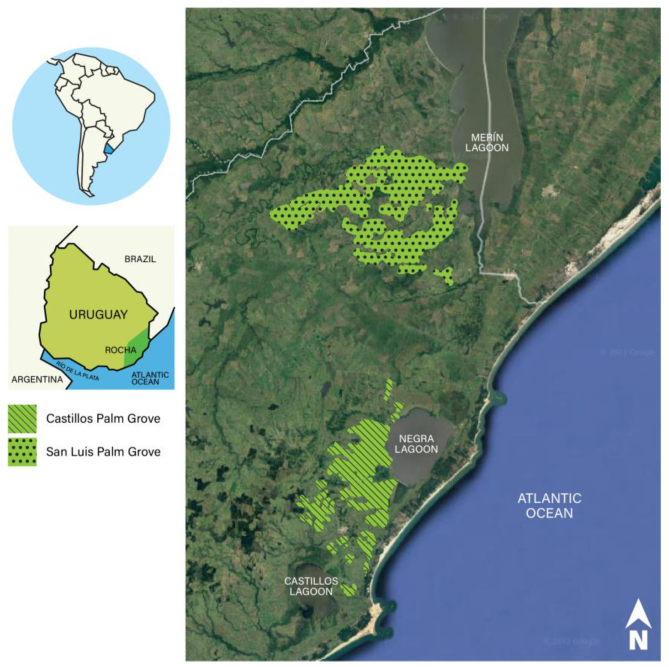
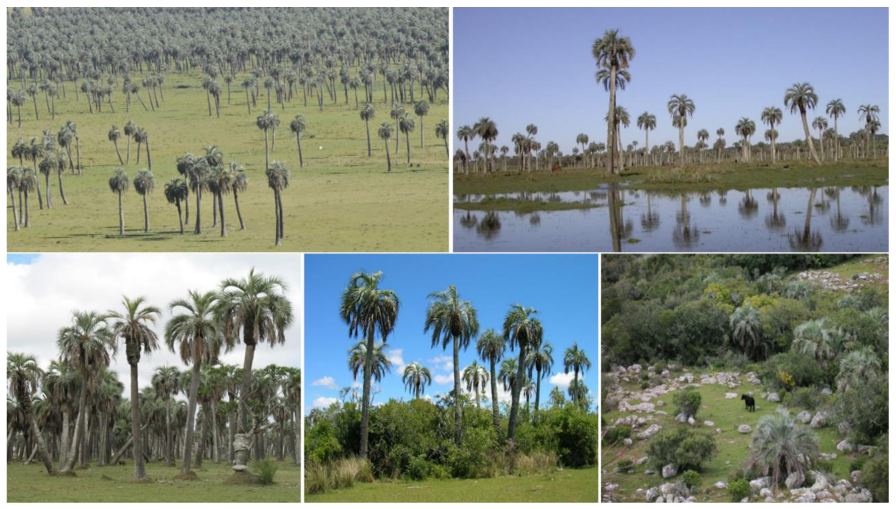
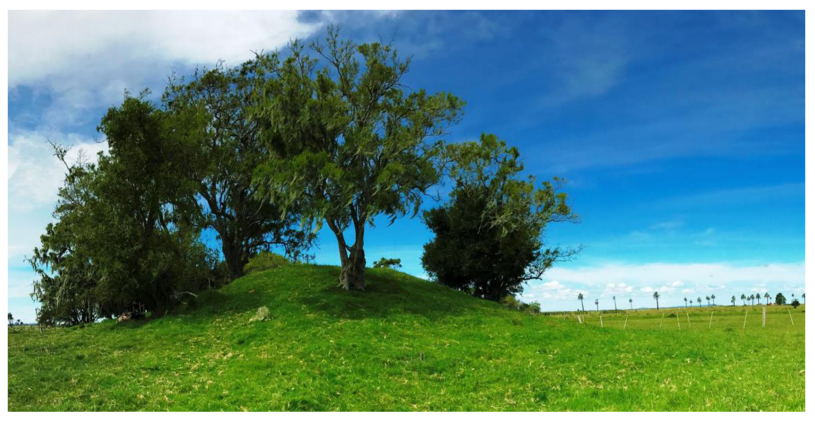

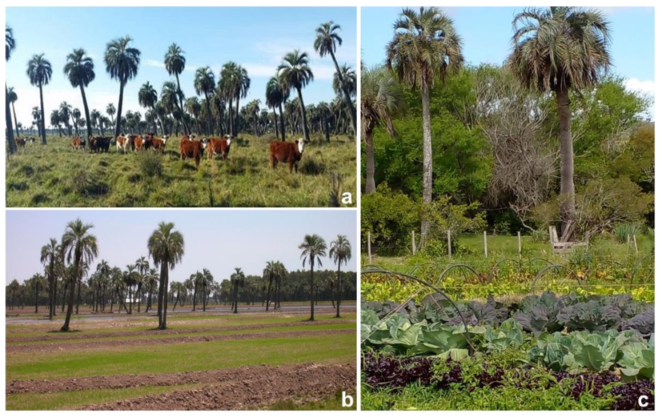
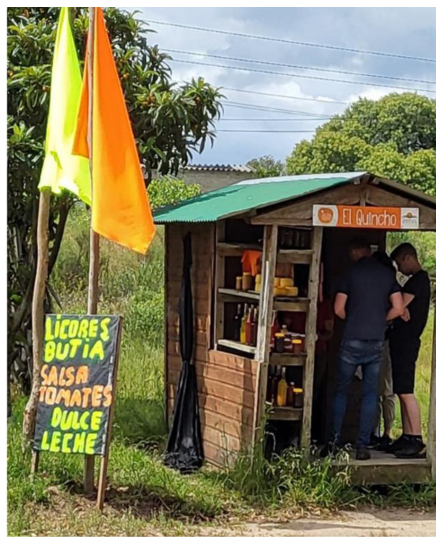
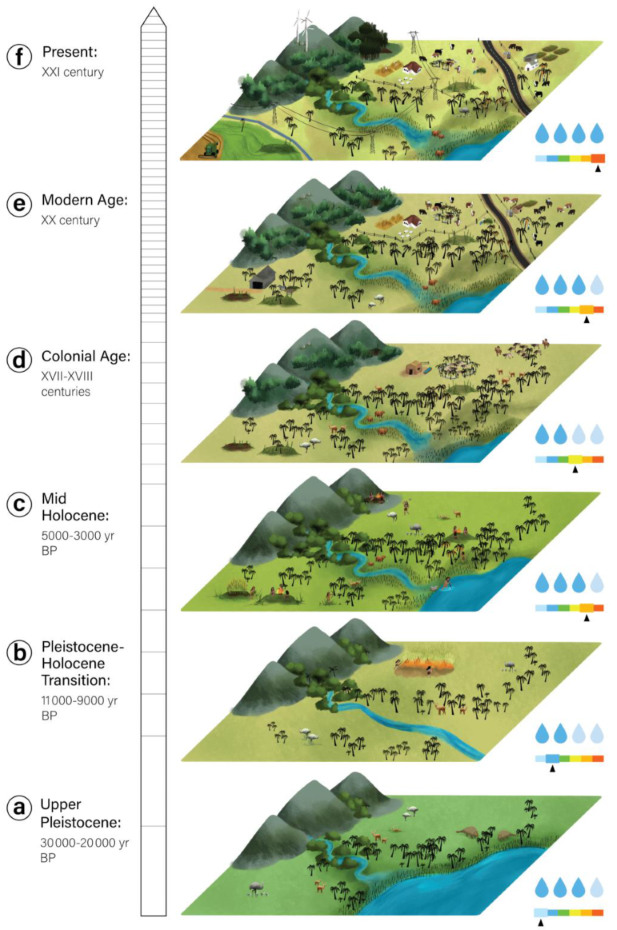
Disclaimer/Publisher’s Note: The statements, opinions and data contained in all publications are solely those of the individual author(s) and contributor(s) and not of MDPI and/or the editor(s). MDPI and/or the editor(s) disclaim responsibility for any injury to people or property resulting from any ideas, methods, instructions or products referred to in the content. |
© 2023 by the authors. Licensee MDPI, Basel, Switzerland. This article is an open access article distributed under the terms and conditions of the Creative Commons Attribution (CC BY) license (https://creativecommons.org/licenses/by/4.0/).
Share and Cite
Rivas, M.; Dabezies, J.M.; del Puerto, L. Historical Evolution and Multidimensional Characterisation of the Butia Palm Landscape: A Comprehensive Conservation Approach. Land 2023, 12, 648. https://doi.org/10.3390/land12030648
Rivas M, Dabezies JM, del Puerto L. Historical Evolution and Multidimensional Characterisation of the Butia Palm Landscape: A Comprehensive Conservation Approach. Land. 2023; 12(3):648. https://doi.org/10.3390/land12030648
Chicago/Turabian StyleRivas, Mercedes, Juan Martín Dabezies, and Laura del Puerto. 2023. "Historical Evolution and Multidimensional Characterisation of the Butia Palm Landscape: A Comprehensive Conservation Approach" Land 12, no. 3: 648. https://doi.org/10.3390/land12030648
APA StyleRivas, M., Dabezies, J. M., & del Puerto, L. (2023). Historical Evolution and Multidimensional Characterisation of the Butia Palm Landscape: A Comprehensive Conservation Approach. Land, 12(3), 648. https://doi.org/10.3390/land12030648





